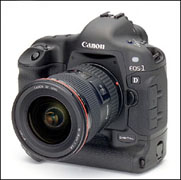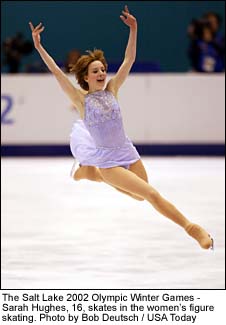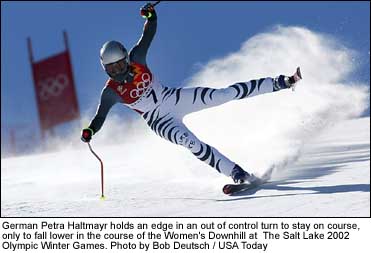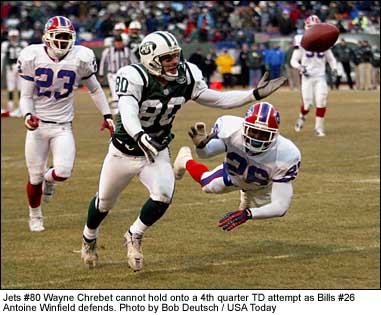The EOS-1D
Digital Camera
Review by Robert Deutsch
USA Today Staff Photographer
|

|
A while back, PF
Bentley wrote in these pages about the new Canon EOS1-D camera. His
point was that for his needs, he would wait for a newer body with a
larger chip that would give him the larger file sizes he feels magazines
need.
However, for a newspaper photographer that does as much sports as I
do, the 1D is a major leap in quality and usability from the digital
choices around before it. I just returned from covering the Olympics
and will admit to chanting "I love my camera!" many times
over the month in Salt Lake City.
I've been using some form of digital camera since the early days of
the Canon analog still video, the Mavica still video, Kodak DCS3, and
the DCS520. All were compromises in usability and quality, big compromises.
Now for the first time, I have a camera that can record what I see.
 The
dreaded shutter lag, which forced me to anticipate my shots, has been
reduced to 55 ms, which is the same as an EOS1V film camera. Now when
I press the shutter, I get what I wanted. Combine that with eight frames
per second, and I can now confidently expect to come back with images
that I used to get on film. At figure skating, leaping and twirling
skaters are no longer a hit and miss shot. Now I get them all. On the
downhill course, I now have three or more sharp frames of an 80 mph
skier flying over a blind jump. I used to be lucky to get one. At the
NCAA basketball tournament, when a player flies in from the foul line
for a dunk I do not have to hope for one frame, I get a burst or three
or four and can pick peak action. In fact, I find myself shooting quick
bursts or 3 frames, knowing that I will get the picture, rather than
holding down the button for a while like I used to on the DCS520's,
hoping for a shot. The
dreaded shutter lag, which forced me to anticipate my shots, has been
reduced to 55 ms, which is the same as an EOS1V film camera. Now when
I press the shutter, I get what I wanted. Combine that with eight frames
per second, and I can now confidently expect to come back with images
that I used to get on film. At figure skating, leaping and twirling
skaters are no longer a hit and miss shot. Now I get them all. On the
downhill course, I now have three or more sharp frames of an 80 mph
skier flying over a blind jump. I used to be lucky to get one. At the
NCAA basketball tournament, when a player flies in from the foul line
for a dunk I do not have to hope for one frame, I get a burst or three
or four and can pick peak action. In fact, I find myself shooting quick
bursts or 3 frames, knowing that I will get the picture, rather than
holding down the button for a while like I used to on the DCS520's,
hoping for a shot.
The quality is also much improved. The larger file size (11.7 MB in
Photoshop) means we can crop some and still have a file that will look
great in newsprint at sizes we generally run. Clearly, much larger files
will look better in the mags or in large prints, but there has to be
a balance in usability. A full frame chip generating 20 MB files is
cool, but there are trade-offs. Larger files would mean fewer frames
per second, and a smaller buffer (as in the Canon D60, a new 6 mega-pixel
CMOS camera just introduced. It does only 3 frames per second). File
sizes in the 1D are twice the size of the previous cameras, and transmitting
over bad hotel or arena analog lines now takes forever. Larger files
are just not practical until broadband is available everywhere. Right
now I like the ability to use a 400mm lens where I used to use a 600mm.
I would lose that in a full frame chip. The 17-35 mm wide zoom is wide
enough most of the time, even with the 1.3x multiplication factor.
 The
camera is solid, one piece, and feels (and looks) just like an EOS1V
film camera. Most important for me was that the viewfinder was a "full
frame view" ...large, bright, just like the EOS1V. No more small
finders that we old farts can't see through. The
camera is solid, one piece, and feels (and looks) just like an EOS1V
film camera. Most important for me was that the viewfinder was a "full
frame view" ...large, bright, just like the EOS1V. No more small
finders that we old farts can't see through.
The chip is a 4.48 megapixel CCD (still smaller than a full 35mm frame,
giving a multiplier of approximately 1.3x). But the viewfinder image
is as large as the 1V. It also displays the frames left on the card
(one choice among several user selectable settings) and also the number
of frames left in the jpeg buffer! That should go a long way to preventing
"running out of bullets" in the buffer.
Pick it up and fire away at 8 fps, and you'll realize at once how much
a different this camera this is from what we have had. I had thought
that we would slow it down some of the time to prevent running the buffer
and running out of disks, but it is not necessary. If you do run the
buffer, it begins to flush immediately and after a second or two you
have several more frames to shoot. You can set it at 3 or 8 fps, and
set personal functions for other high and low settings. So in effect
you can set it at 4 different frame rates (3, 4, 6, or 8, for example).
Many other custom functions and personal function sets are available
to completely personalize the camera's operation.
 The
1D can generate Raw files and Jpeg's simultaneously if desired, but
that fills disks very quickly and adversely affects the buffer replenishment,
so I've avoided it. Autofocus is the same as the 1V, with 45 AF points
and all that, and works great. The combination of a fast motor, no lag,
and great autofocus means I now come back with many more "moment"
images than I used to. The
1D can generate Raw files and Jpeg's simultaneously if desired, but
that fills disks very quickly and adversely affects the buffer replenishment,
so I've avoided it. Autofocus is the same as the 1V, with 45 AF points
and all that, and works great. The combination of a fast motor, no lag,
and great autofocus means I now come back with many more "moment"
images than I used to.
Flash sync is at 1/500 sec. (or more, with reduced exposure), and does
true TTL. It is safe to use with strobes with sync line voltages up
to 250 volts, including the old unmodified Speedotrons, without filters.
The PC sync socket is non-polarized, so no more having to switch polarity.
ASA is from 200 to 1600, with ASA 100 and 3200 available as a user setting.
There is a user setting to keep the camera "alive" for up
to an hour, so no external "keep alive" switch is needed for
remote uses (but it will drain the battery faster). The remote plug
is the same as the 1V, the D2000/DCS520 and the D30. And if you get
caught in the rain, it is sealed (when used with new IS lenses) and
I'm told it will be fine, but don't confuse it for an underwater housing.
Canon kept the ability to record sound files (.wav files) matched to
a specific frame. However, it takes three seconds of holding down the
record button (after the buffer is cleared) before recording begins.
This must be shortened, as the next play often begins before that.
There is no zoom to the preview display, a feature I do not miss but
others have asked for.
The image quality is excellent, far better than previous bodies. The
early cameras had some "banding" noise visible in dark sections
of high ASA images, but this has been reduced with firmware updates.
Also, a line can appear on the edge of similar images, but this can
be fixed with a hardware update available by returning to Canon. Newer
1D's have these fixes installed already. Exposure is consistent and
accurate, especially in auto modes. When shooting Jpeg's, it is critical
to be accurate. There is no fudge factor such as "exposure throttle"
that we used with the older Kodak Tiffs, so you need to be as accurate
as if shooting chromes on film. Raw files can be tweaked for exposure
and balance, but for now the Canon software available to process Raw
files is so slow that it is not workable on deadline. Hopefully, this
will be corrected and the SDK made available to other companies who
produce great editing software.
 I
try to stay at or below 800 ASA most of the time, but have shot acceptable
images at up to 1600 ASA. As a test, I shot some action at 3200 at the
World Series, and except for some visible noise, it looked remarkably
good. Most of the photographers I showed these images to thought they
were taken at 800 ASA! You do have to make sure that there is no underexposure,
to keep the noise down. I
try to stay at or below 800 ASA most of the time, but have shot acceptable
images at up to 1600 ASA. As a test, I shot some action at 3200 at the
World Series, and except for some visible noise, it looked remarkably
good. Most of the photographers I showed these images to thought they
were taken at 800 ASA! You do have to make sure that there is no underexposure,
to keep the noise down.
There are several white balance choices, including auto, custom, and
even the ability to dial in a specific Kelvin degree setting. It's hard,
even in bad arena lighting, to not be able to get a balanced picture.
Nothing is perfect though, and there are some issues that I wish were
better designed. The card door and battery release tabs are very hard
to open, especially if wearing gloves. I've had to put gaffer tape on
the door tab to help grab it. You'll need plenty of batteries, probably
2 or 3 per camera. Even if properly charged and refreshed, they go fast,
especially in the cold, or if "chimping", autofocusing, and
using IS lenses. Get extra! If working in the cold for a long time,
consider an external battery such as the well made "Digital Camera
Battery"(www.digitalcamerabattery.com
). Canon recommends 3 refresh cycles when new, and monthly after that
under normal PJ use.
So while some photographers will want a larger chip camera and can cope
with slow motors and large files, those of us shooting sports and fast
moving news in remote locations will be thrilled with the new Canon
EOS1D. You might even find yourself at the top of a ski hill someday
chanting, "I love my camera."
For more information
on the Canon EOS 1D, visit
Canon's website.
|

 The
dreaded shutter lag, which forced me to anticipate my shots, has been
reduced to 55 ms, which is the same as an EOS1V film camera. Now when
I press the shutter, I get what I wanted. Combine that with eight frames
per second, and I can now confidently expect to come back with images
that I used to get on film. At figure skating, leaping and twirling
skaters are no longer a hit and miss shot. Now I get them all. On the
downhill course, I now have three or more sharp frames of an 80 mph
skier flying over a blind jump. I used to be lucky to get one. At the
NCAA basketball tournament, when a player flies in from the foul line
for a dunk I do not have to hope for one frame, I get a burst or three
or four and can pick peak action. In fact, I find myself shooting quick
bursts or 3 frames, knowing that I will get the picture, rather than
holding down the button for a while like I used to on the DCS520's,
hoping for a shot.
The
dreaded shutter lag, which forced me to anticipate my shots, has been
reduced to 55 ms, which is the same as an EOS1V film camera. Now when
I press the shutter, I get what I wanted. Combine that with eight frames
per second, and I can now confidently expect to come back with images
that I used to get on film. At figure skating, leaping and twirling
skaters are no longer a hit and miss shot. Now I get them all. On the
downhill course, I now have three or more sharp frames of an 80 mph
skier flying over a blind jump. I used to be lucky to get one. At the
NCAA basketball tournament, when a player flies in from the foul line
for a dunk I do not have to hope for one frame, I get a burst or three
or four and can pick peak action. In fact, I find myself shooting quick
bursts or 3 frames, knowing that I will get the picture, rather than
holding down the button for a while like I used to on the DCS520's,
hoping for a shot. The
camera is solid, one piece, and feels (and looks) just like an EOS1V
film camera. Most important for me was that the viewfinder was a "full
frame view" ...large, bright, just like the EOS1V. No more small
finders that we old farts can't see through.
The
camera is solid, one piece, and feels (and looks) just like an EOS1V
film camera. Most important for me was that the viewfinder was a "full
frame view" ...large, bright, just like the EOS1V. No more small
finders that we old farts can't see through. The
1D can generate Raw files and Jpeg's simultaneously if desired, but
that fills disks very quickly and adversely affects the buffer replenishment,
so I've avoided it. Autofocus is the same as the 1V, with 45 AF points
and all that, and works great. The combination of a fast motor, no lag,
and great autofocus means I now come back with many more "moment"
images than I used to.
The
1D can generate Raw files and Jpeg's simultaneously if desired, but
that fills disks very quickly and adversely affects the buffer replenishment,
so I've avoided it. Autofocus is the same as the 1V, with 45 AF points
and all that, and works great. The combination of a fast motor, no lag,
and great autofocus means I now come back with many more "moment"
images than I used to. I
try to stay at or below 800 ASA most of the time, but have shot acceptable
images at up to 1600 ASA. As a test, I shot some action at 3200 at the
World Series, and except for some visible noise, it looked remarkably
good. Most of the photographers I showed these images to thought they
were taken at 800 ASA! You do have to make sure that there is no underexposure,
to keep the noise down.
I
try to stay at or below 800 ASA most of the time, but have shot acceptable
images at up to 1600 ASA. As a test, I shot some action at 3200 at the
World Series, and except for some visible noise, it looked remarkably
good. Most of the photographers I showed these images to thought they
were taken at 800 ASA! You do have to make sure that there is no underexposure,
to keep the noise down.